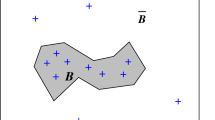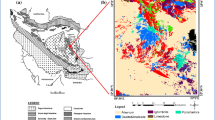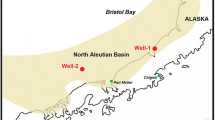Abstract
A methology to define favorable areas in petroleum and mineral exploration is applied, which consists in weighting the exploratory variables, in order to characterize their importance as exploration guides. The exploration data are spatially integrated in the selected area to establish the association between variables and deposits, and the relationships among distribution, topology, and indicator pattern of all variables. Two methods of statistical analysis were compared. The first one is the Weights of Evidence Modeling, a conditional probability approach (Agterberg, 1989a), and the second one is the Principal Components Analysis (Pan, 1993). In the conditional method, the favorability estimation is based on the probability of deposit and variable joint occurrence, with the weights being defined as natural logarithms of likelihood ratios. In the multivariate analysis, the cells which contain deposits are selected as control cells and the weights are determined by eigendecomposition, being represented by the coefficients of the eigenvector related to the system’s largest eigenvalue. The two techniques of weighting and complementary procedures were tested on two case studies: 1. Recôncavo Basin, Northeast Brazil (for Petroleum) and 2. Itaiacoca Formation of Ribeira Belt, Southeast Brazil (for Pb-Zn Mississippi Valley Type deposits). The applied methdology proved to be easy to use and of great assistance to predict the favorability in large areas, particularly in the initial phase of exploration programs.
Similar content being viewed by others
References
Adams, S., 1986. Using geological information to develop exploration strategies for epithermal deposits in Epithermal Deposits, Chapter 12, p. 273–298.
Agterberg, F. P., Systematic approach to dealing with uncertainty of geoscience information in mineral exploration, in Apcom Symposium, 21sth., 1989. Las Vegas.Proceedings. Las Vegas, p. 165–178.
Agterberg, F. P., 1989b. Computer Programs for Mineral Exploration.Science, v. 245, p. 76–81.
Bonham-Carter, G. F., Agterberg, F. P., and Wright, D. F., 1989. Weights of evidence modelling: a new approach to mapping mineral potential.Geological Survey of Canada, Paper n. 89 9, p. 171–183.
Bonham-Carter, G. F., 1994,Geographic Information Systems for Geoscientists—Modelling with GIS.. Computer Methods in the Geosciences, Volume 13. 1st edition, Canada, Pergamon Press, 398p.
Carozzi, A. V., Araujo, M. B., Césero, P., Fonseca, J. R., Silva, V. J. L., Formação Salvador, 1976 um modelo de deposição gravitacional subaquosa.Boletim Técnico da Petrobrás, Rio de Janeiro, v. 19, n.2, p. 47–79.
Carr, J. R., 1995.Numerical analysis for the geological sciences. New Jersey: Prentice-Hall, p. 592.
Chung, C. F., Jefferson, C. W., and Singer, D. A., 1992. A quantitative link among mineral deposit modeling, geoscience mapping, and exploration-resource assessment.Economic Geology, v.87, p. 194–197, 1986.
Cox, D. P., Singer, D. A., 1986. eds. Mineral Deposit Models.U. S. Geological Survey Bulletin n. 1693. 379 p.
Davis, J. C. 1986.Statistics and data analysis in geology. 2nd. Ed.: New York: John Wiley, 646p.
Figueiredo, A. M. F., Braga, J. A. E., Zabalaga, J. C., Oliveira, J. J., Aguiar, G. A., Silva, O. B., Mato, L. F., Daniel, L. M. F., Magnavita, L. P., Bruhn, C. H. L., 1994, Recôncavo basin, Brazil: a prolific intracontinental rift basin.The American Association of Petroleum Geologists Memoir n. 59, p. 157–203.
Harff, J. and Davis, J. C., 1990. Regionalization in geology by multivariate classification.Mathematical Geology, v.22, n. 5, p. 573–588.
Henley, R. W. and Berger, B. R., 1993, What is an exploration model anyway?—an analysis of the, cognitive development and use of models in mineral exploration.Geological Association of Canada Special Paper n. 40, p. 41–50.
Magnavita, L. P., Davison, I., and Kusznir, N. J., 1994. Rifting, erosion, and uplift history of the Recôncavo-Tucano-Jatobá Rift, northeast Brazil.Tectonics, v.13, n. 2, p. 367–388.
Magoon, L. B. and Dow, W. G., 1994, The petroleum system.The American Association of Petroleum Geologists Memoir n. 60, p. 3–24.
McCammon, R. B., Botbol, J. M., Sinding-Larsen, R., Bowen, R. W., 1983. Characteristic analysis–1981: final program and a possible discovery.Mathematical Geology, v. 15, n. 1, p. 59–83.
McCammon, R. B., Finch, W. I., Kork, J. O., Bridges, N. J., 1994, An integrated data-directed numerical method for estimating the undiscovered mineral endowment in a region.Nonrenewable Resources, v. 3, no. 11, p. 109–122.
Milani, E. J. and Davison, I., 1988, Basement control and transfer tectonics in the Recôncavo-Tucano-Jatobá Rift, Northeast Brazil.Tectonophysics, no. 154, p. 41–70.
Mosier, D. L. and Bliss, J. D., 1992, Introduction and overview of mineral deposit modeling.U.S. Geological Survey Bulletin n. 2004, p. 1–5.
Pan, G., 1993, Regionalized favorability theory for information synthesis in mineral exploration.Mathematical Geology, v. 25, n. 5, p. 603–631.
Pan, G. and Porterfield, B., 1995. Large-scale mineral potential estimation for blind precious metal ore bodies.Nonrenewable Resources, v. 4, p. 187–207.
Rose, P. R. 1993, Chance of success and its use in petroleum exploration.in Steinmetz, R. ed., The business of petroleum exploration.The American Association of Petroleum Geologists Treatise of Petroleum Geology, p. 71–86.
Soares, P. C., Stevanato, R., Camargo, C. R., 1987, Geologia do nordeste da Faxia Itaiacoco—Parana. In: Simpósio Sul-Brasileiro de Geologia 3., 1987.Atas... Curitiba. SBG, p. 245–262.
Stevanato, R., 1996. Modello exploratório para Pb e Zn na região de Palmeirinha/Senges—PR/SP. Dissertation Thesis. Geology Department—UFPR. Brazil.
Author information
Authors and Affiliations
Rights and permissions
About this article
Cite this article
Rostirolla, S.P., Soares, P.C. & Chang, H.K. Bayesian and multivariate methods applied to favorability quantification in Recôncavo Basin and Ribeira Belt, Brazil. Nat Resour Res 7, 7–24 (1998). https://doi.org/10.1007/BF02782505
Received:
Accepted:
Issue Date:
DOI: https://doi.org/10.1007/BF02782505




